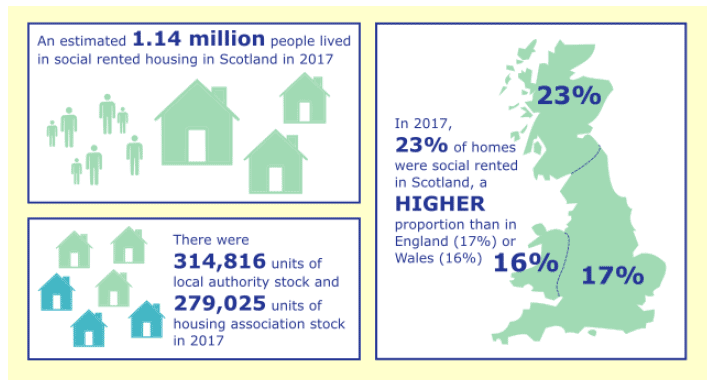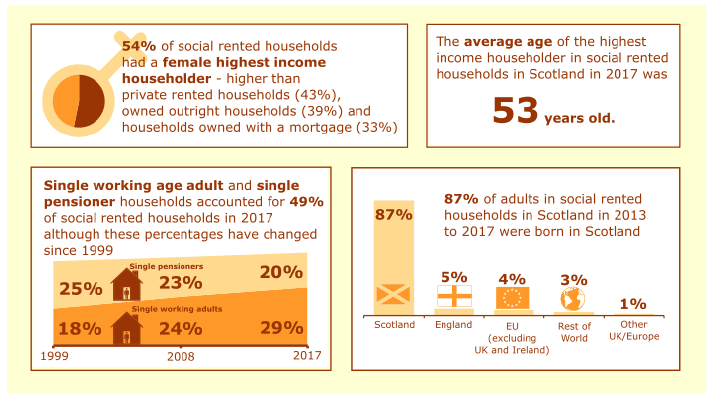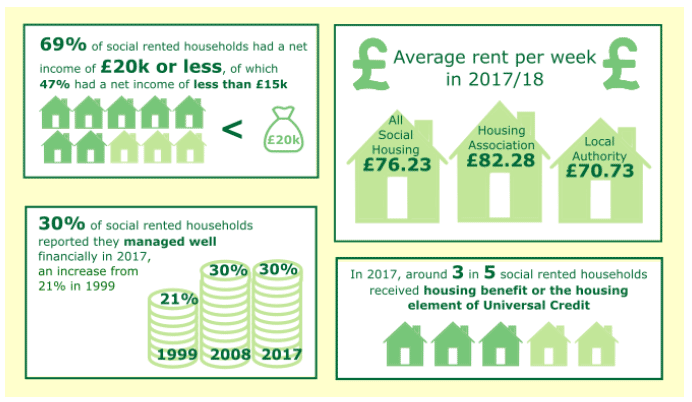Social tenants in Scotland 2017
Overview of social tenants and social rented housing in Scotland for 2017, covering information on stock, households, housing flows, rents and income.
Key Findings
Number of Social Tenants and Social Housing Stock Provision:
Infographic:

Infographic text:
- An Estimated 1.14 million people lived in social rented housing in Scotland in 2017.
- There were 314,816 units of local authority stock and 279,025 units of housing association stock 2017.
- In 2017, 23% of homes were social rented in Scotland a higher proportion than in England (17%) or Wales (16%).
- There were an estimated 1.14 million people living in social rented housing in Scotland in 2017, a similar figure to the estimated 1.17 million people in the previous year.
- Similar to the previous three years, social rented housing stock in 2016 was provided by 161 housing associations and 26 out of 32 local authorities. (With 6 authorities no longer managing housing stock due to previous stock transfers to housing associations).
- Social rented housing stock in 2017 totalled 593,841 units (314,816 local authority properties and 279,025, housing association properties), a slight decrease of 791 (0.1%) homes from 594,632 units in 2016.
- Local authorities generally had a larger size of stock in 2017 compared to housing associations, with almost two-thirds (65%) of the 26 local authorities having stock levels between 5,001 and 20,000 homes, whilst more than eight in ten (83%) housing associations had stock levels of 2,500 homes or less. There has been little change to this pattern since 2014.
- 69% of housing associations operated in a single local authority area in 2017, 17% operated in 2 to 5 different local authority areas, whilst the remaining 14% operated across 6 or more local authority areas.
- At a Scotland level 53% of social rented housing stock in 2017 was owned by local authorities, with 47% being owned by housing associations.
- In 2017 Scotland had a higher proportion of social renting stock (23%) compared to both England (17%) and Wales (16%).
Characteristics of Social Tenants:
Infographic:

Infographic text:
- 54% of social rented households had a female highest income householder - higher than private rented households (43%), owned outright households (39%) and households owned with a mortgage (33%).
- The average age of the highest income householder in social rented households in Scotland in 2017 was 53 years old.
- Single working age adult and single pensioner households accounted for 49% of social rented households in 2017 although these percentages have changed since 1999.
- 87% of adults in social rented households in Scotland in 2013 to 2017 were born in Scotland.
- 29% of social rented households in 2017 were single working age adults, an increase from 18% in 1999. 20% of households were single pensioners, a decrease from 25% in 1999.
- The average age of the highest income householder in social rented housing in 2017 was 53 years, the same value as the average age in 1999.
- Social rented households in Scotland in 2017 had a higher proportion of female highest income householders (54%) than private rented households (43%), households with the property bought with a mortgage (33%) and households where the property was owned outright (39%).
- 38% of adults in social rented households in 2017 were employed (24% employed full time, 11% employed part time, and 2% self-employed). 25% of adults were retired from work, 12% were permanently sick or disabled, 9% were looking after the home or family, and 9% were unemployed and seeking work.
- In the period 2013 to 2017, 86% of adults in social rented households stated they were 'White Scottish', a higher percentage than private rented households (57%).
- In the period 2013 to 2017, 87% of adults in social rented households were born in Scotland, 5% were born in England, 4% were born in the EU (excluding UK and Ireland), and 3% were born in the rest of the world.
- In the period from 2013 to 2017, 53% of adults in social rented housing said they had no religion, an increase on the 45% between 2009 and 2012. The percentage of adults with a Church of Scotland religion decreased over this time period from 29% to 22%, whilst the proportion with a Roman Catholic religion stayed similar from 18% to 17%.
- 3% of adults in social rented households identified as lesbian, gay, bisexual or other in 2017, compared to 5% of adults in the private rented sector, 2% of adults in households owned with a mortgage, and 1% of adults in households that were owned outright.
Housing Flows:
Infographic:

Infographic text:
- There were 53,602 social housing lets in 2017/18.
- 35% of local authority & 52% of housing association lets were to housing list applicants. (where applicant was not already an existing tenant).
- Social rented housing lets in 2017/18: 14% supported housing lets, 86% general needs lets.
- Social rented households - Average length of time at current address : 11 years.
- In 2017/18 there were a total of 53,602 social rented housing lets, an increase of 678 lets, or 1%, on the 52,924 lets in 2016/17, although the number of lets has fallen by 7% over the period from 2013/14 to 2017/18.
- In 2017/18 48% of lets were by local authorities, and 52% were by housing associations. This compares to local authorities having 53% of all social rented housing stock as at March 2017.
- 35% of lets by local authorities in 2017/18 were to housing list applicants, compared to 52% of lets by housing associations. (Where applicants were not already existing tenants).
- In 2017/18 90% of local authority lets and 82% of housing association lets were general needs lets.
- Adults in social rented households in Scotland in 2017 had been at their current address for an average of 11 years, a slightly shorter average time than in 1999 (12 years).
- Local authority properties were on average empty for 34.3 calendar days before being re-let in 2017/18. Housing association properties were on average empty for 27.2 calendar days.
- For social rented households in Scotland in which an adult had moved into the address within the last 12 months in 2016, almost half of adults (45%) had a previous address which was also social rented. 22% had a previous address that was rented privately and 21% had a previous address that was their parental/family home.
Housing Costs and Income:
Infographic:

Infographic text:
- 69% of social rented households had a net income of £20k or less, of which 47% had a net income of less than £15k.
- 30% of social rented households reported they managed well financially in 2017, an increase from 21% in 1999.
- Average rent per week in 2017/18: All Social Housing £76.23. Housing Association £82.28. Local Authority £70.73.
- In 2017, around 3 in 5 social rented households received housing benefit or the housing element of Universal Credit.
- The average weekly rent for a social sector property in Scotland in 2017/18 was £76.23, an increase of 2.4% on the previous year. Housing association rents averaged £82.28 per week, 16% higher than local authority rents of £70.73.
- In 2017/18, the £70.73 average weekly local authority rent in Scotland was around 18% lower than in England (£86.71), and around 16% lower than in Wales (£84.65). The £82.28 average weekly housing association rent in Scotland was around 14% lower than in England (£95.59), and around 6% lower than in Wales (£87.10).
- 69% of social rented households in 2017 had a net income of £20k or less, which compares to 46% of private rented households, 46% of households owned outright and 14% of households buying with a mortgage.
- Across the period 2015/16 to 2017/18, social rented households in Scotland spent an average of 24% of their net income on housing costs. This figure compares to equivalent figures of 27% for private rented households, 8% for households owning their property with a mortgage and 3% for households owning their property outright. (Note that housing costs include rent gross of Housing Benefit, as well as water rates and service charges where applicable. Net income relates to all household income after personal taxes and council tax have been netted off. See Section 5 for further details of how this percentage figure has been calculated).
- 34% of social rented households in Scotland spent more than 30% of their net income on housing costs in the period 2015/16 to 2017/18, lower than the equivalent figures of 49% for England and 48% for Wales.
- 59% of social rented households received Housing Benefit in 2017, with a further 2% receiving the housing element of universal credit. This compares to 21% of private rented sector households receiving Housing Benefit, with a further 2% receiving the housing element of universal credit.
- For households claiming Housing Benefit, social rented households had on average 94% of the value of their housing costs covered by Housing Benefit (calculation based on a median ratio figure), which compares to 83% for private rented households.
- In 2017, 30% of social rented households in Scotland stated that they managed well financially, an increase from 21% in 1999.
Contact
There is a problem
Thanks for your feedback